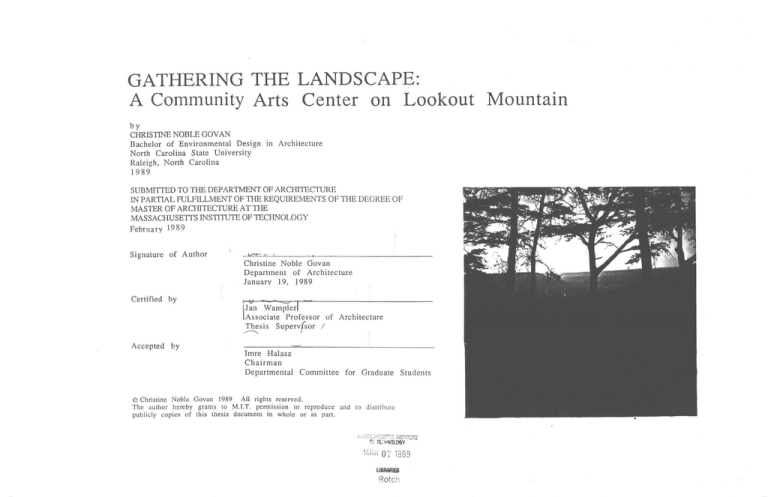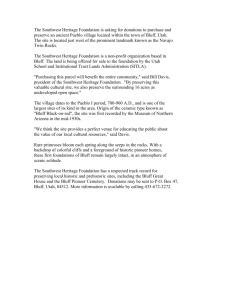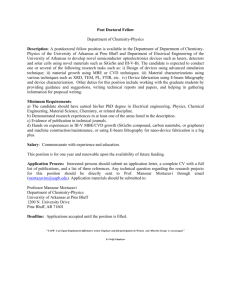
GATHERING THE LANDSCAPE:
A Community Arts Center on Lookout Mountain
by
CHRISTINE NOBLE GOVAN
Bachelor of Environmental Design in Architecture
North Carolina State University
Raleigh, North Carolina
1989
SUBMITTED TO THE DEPARTMENT OF ARCHITECTURE
IN PARTIAL FULFILLMENT OF THE REQUIREMENTS OF THE DEGREE OF
MASTER OF ARCHITECTURE AT THE
MASSACHUSETTS INSTITUTE OF TECHNOLOGY
February 1989
Signature of Author
Lf."W -
..
--
I
Christine Noble Govan
Department of Architecture
January 19, 1989
Certified by
Jan Wamplerl
Associate Professor of Architecture
Thesis Superv sor /
Accepted by
Imre Halasz
Chairman
Departmental Committee for Graduate Students
All rights reserved.
@ Christine Noble Govan 1989
author
hereby
grants
to
M.I.T.
permission to reproduce and to
The
publicly copies of this thesis document in whole or in part.
distribute
TE"'fOLOGY
UM 07 1989
ROtch
ABSTRACT
-
6
.0
b.
.4
-i. .
r,
'00..
4 1r.f
-.
7
-
GATHERING THE LANDSCAPE: A Community
Arts Center on Lookout Mountain
by
Christine Noble Govan
Submitted to the Department of Architecture on January 19, 1989 in partial fulfillment of
the requirements for the Degree of Master of Architecture
With a tape measure and a pad of
newsprint, to document, understand and
re-present a natural place was the first
From this
goal of this thesis.
understanding a new built presence, a
to
redefinition of the site, is sought,
gather its essential properties and bring
This thesis aims at
them close.
achieving a continuity of experience
between the built and the natural, at
achieving new transformative readings
of each, in which one order is
juxtaposed against and thereby defines
the other.
Focusing on the exchange between
these two worlds, explorations are made
into levels of built and unbuilt, into
where, how, and how much to transform
what was there. Through this interplay
of inside and outside, built and natural,
permanent and transitory, the intention
is to bring to people a new awareness
and sense of belonging to the site, of the
dynamics of natural forces, and of their
specific location in the context of these
For ultimately, all
larger orders.
architecture is an infill project relative
to the earth. It is our connection to this
outer world upon which our sense of
belonging
depends.
Jan Wampler
Thesis Supervisor:
Associate Professor of Architecture
Title:
2
Dedicated to my mother.
-~
wt.~
3
TS
TABLEOF)CONTEN
~ ~'*.~
.%~*
-
*~
**
*d*.q~.*.~?*
ABSTRACT
2
SITE ANALYSIS
5
Geology
Paths,
Places
DESIGN EXPLORATIONS
Program
Local
a
References
BuiLingProjectonsY
BIBLIOGRAPHY
18
20
- 22
48
4
SITE ANALYSIS
0-4b-, i
-0.0...-..
1
--------------
Geology
As
part
of
the
site
~
analysis,
understanding the geological formation
of the site was vital to understanding its
character and structure, while also
perhaps giving clues as to how the
building itself might be formed.
The site is situated in Johnson
Crook, a south-facing indentation along
the bluff of Lookout Mountain in the
town of New Salem, Georgia. As part of
the sinuous course of the Appalachian
system, stretching over 1,500 miles
from Newfoundland to Alabama, its
making is due to collisions which
happened over 300 million years ago.
Huge plates containing North America,
Africa, Europe and South America
slowly crept closer to each other, finally
joining to form a super-continent,
leaving marks on their plate edges. The
i
A4
5
Appalachian Plateaus, of which Lookout
Mountain is a part, is the last in a series
of deformations resulting from this
collision emanating westward from the
Blue Ridge.
The pointed metamorphic
rock of the crystalline Blue Ridge stands
in sharp contrast to the flat sedimentary
rock of the Appalachian Plateaus.
Limestone
laid
down
in the
sea
underlies this plateau region.
Where
pushed up as mountains and exposed,
this soft limestone has eroded away to
form present day valleys.
Conversely,
the valleys, where hard layers of
sandstone had been deposited, have
survived
to
become
present
day
mountains.
So ironically, the mountains
today are the skeletons of ancient
valleys, the eroded remnants of a far
taller range, the "Old Appalachians."
The strata of these sedimentary
Appalachians have been flexed into a
succession of anticlines and synclines,
with folds crowded tightly against each
other. These folds trend in a northeastsouthwest direction, parallel to the
major structural axis of the folded
Appalachians, though they are often
broken and overturned by faults.
Large
thrust faults underlay the Appalachian
Plateaus.
Low angle thrusts tore loose
6
LO~kOA~oO~~tJChickarna~js,
Ridge
sdcMtnMssionary
A
Coie C-tY
Se eOck
5-
c.
oOI
On 0
Orni
01"
OCk
dn
Cvmybne
rIa
n dep
Sequatchie
'V,)Iey
I a
enaeu
V aI
-zTC
1I
ya
nd
de
P r ov
on oim
n ce
e
R id~
Ck Cc
higher parts from lower parts along
weak shaly layers, carrying sheets of
rock atop others miles northwest.
The site testifies to this ancient
sandstone
Resistant
formmaking.
projects high as ridges on Lookout while
the more vulnerable limestone, which
forms the lower third of the mountain,
has been eroded by water and the acid
from rotting leaves, dissolving out large
cavern systems.
The horizontal layering of the
sandstone is a strong feature of the site.
These layers vary along the bluff edge
from small thin layers to places where
the rock bedded in big, thick slabs. This
finely layered sandstone makes up the
top zone of the bluff wall. Behaving like
IJ,
shifting plates, these sheets of rock
weave in and out of the trees,
cantilevering far out in places to form
Shifting and
dramatic outcroppings.
colliding along the edge, they reflect the
dynamics of the shifting earth sheets
which first formed the Appalachians.
Below this top layer, the bluff
wall, where the insides of the earth are
revealed, is composed of rock of a
different
character.
Older,
more
weathered sandstone has been divided
vertically into larger chunks by planes
-7
the bluff.
Many of the cumulative layers have
been cemented together, with the rock
appearing round, soft and lava-like.
Undulating horizontal lines sweep the
of energy
like
paths
face,
rock
describing the stress flow, evidence of
the ancient force and folding of the rock.
The great round rock walls undulate as
well, as if pushed out by some force
of
stress
perpendicular
to
behind.
On a larger scale, the site can be
An
seen as two giant plates colliding.
upper bluff forms the crest of the site
while a lower bluff sweeps in below.
Understanding the bluff as two larger
pieces
proved
valuable
later
in
determining
where
and
how
the
building might sit relative to this
collision point.
8
SITE ANALYSIS
ar
o
-95
a -=.
-
V-0
95i*
495Aft
~
qa
~
*4.
.
.*4...:...--~-'
~*.'&
4i
5
Paths,
Beyond its geology, further
analysis aims at understanding
lae
site
the
natural organization of this place as a
of
spatial
system
meaningful
relationships, as a set of 'insides' from
the macro to micro levels. It is a site so
built by the earth that it can be seen as
a piece of architecture itself, with its
own rules,
structure and essential
'1
-
character.
-
LOCATION
The situation of this site offers
excellent opportunities for orientation.
Located in a south-facing concavity,
Johnson Crook, which opens up to the
long narrow valley between Lookout
and Sand Mountains, it is a place where
and
enclosure
natural
exposure
Even within the large scale
collaborate.
~G
, .k
?
~
~9;.
-4
5
ON SITE MEASUREMENT DRAWING
9
of the southern Appalachian range, it is
niche.
a habitable
as
identifiable
Cradled in this cup looking southwest
along the Appalachian Valley you have
no question as to where you are or what
immediate
your
define
boundaries
world.
Scaling down to the size of the
site, approximately 600 feet by 350
feet, the task is to map the site in terms
of paths, places, districts, landmarks,
similar to a Kevin Lynch image map, a
way of naming, and thereby locating
Similarly, most of the names in
you.
10
this region refer to some physical
Lookout Mountain, Plum Nelly
location:
("Plum out of Georgia and Nelly out of
Tennessee"), Valley View, Eagle Cliff.
Three major outlooks divide this
stretch of bluff into two nearly equal
The middle
halves of 270 feet each.
outcropping is the most prominent
projection, marking the precinct of
dramatic rocky ledges that distinguish
Steps built between
the upper bluff.
these rocks lead to a cave underneath.
Traveling along the edge, the land
descends to another set of steps built at
what seems to be the collision point of
the upper and lower bluffs, marked by
a pile of crashed rocks, as if frozen in
the midst of colliding. These steps lead
to a lower dish-like place, with the land
eventually climbing up again to the
However if you
third major outlook.
follow the flow of the land down, you
are led naturally to venture below the
bluff and walk along its bottom edge.
The land comes up here from below, as
if to greet you,
drop of 25 feet to
big round boulder
descent, it seems
the world of the
walls below.
decreasing the usual
only 10 feet. With a
marking the place of
a natural entrance to
cool, undulating rock
tn
V
.~
~j~i.k~-
A
-
I'
A'.
I
/
----------"*-----
-
.r~.
--
~--.-
Behind the paths which play along
the edge, the forested ground slopes
gently back to the road, except for the
flat clearing around the old house of the
artist who once owned this land.
The movement of the land is
another essential characteristic of the
Like a river downstream, you are
site.
carried along by the current of the land
with outlooks, platforms and the lower
dish-like space acting as pools and
eddies catching the flow.
In addition to events occuring
parallel to the bluff, distinct zones mark
your movement perpendicular to the
The site more than anything else
bluff.
You are always aware of
is an edge.
to this
in relation
your position
powerful, large scale, referential edge,
the thing you share with everyone
along the bluff, the belly of
mountain.
12
else
the
THE APPROACH SEQUENCE
The movement toward the edge
actually begins with your drive to the
Openings between trees offer
site.
peeks to the vista beyond, punctuating
your journey to the back of the
Driving up to the site,
mountain.
enough light filters through the forest to
Dense
let you know the edge is near.
woods constrain your movement as you
ascend toward the bluff. Once free from
the forest, the blue mountains, like the
sea, rise on the horizon in the distance.
*4w7raw-l"
13
The view out is partially obscured
by a thin, teasing screen of trees, which
marks the zone just behind the bluff.
The Jack Pine, a rugged, Japanese-like
pine tree grows directly out of the rock,
with hovering horizontal
ledges of
green, similar to the ledges of rock
below.
Here the immediacy and detail
of the
near
against
is juxtaposed
infinity, of the valley beyond.
and openness
edge.
14
draws
you
to
the
The light
the
bluff
i
*.r
Being out on the tips of the rocky
ledges, you are finally free from any
immediate containment, wide, open, up
The
You are in the treetops.
and out.
sky dominates and the land rolls out
from beneath you forever.
Release.
Calm.
15
In sharp contrast is the more
enclosed earth-dominated world of the
bluff wall below.
Here the walls act as
light-catchers, drawing your attention
up to the sliver of sky revealed between
the bluff edge and the treetops.
A cool,
dappled light is cast on these powerful
rocks from the screen of trees, seeming
even lighter in relation to the rock wall.
Here also, you feel very much down, up
against (nearly in) the earth, in contrast
to the high-up, close-to-flight feeling of
the outcroppings above.
16
/
-
-,
\
~'
I
-I
17
DESIGN EXPLORATIONS
Pr og ram
The program for the building is an
arts and crafts center, a loose gathering
of workshops, studio and exhibit spaces,
where classes are held, studios can be
rented and shows are open to the
public. A place of healing, rejuvenation,
reconnection, where people come to get
their hands in some clay.
Several places of similar program
were visited as references,.the Penland
School in North Carolina coming closest
and
atmosphere
of
terms
in
Like a summer camp,
organization.
modest buildings were linked by paths
organized around a communal space.
Buildings had been acquired as needed
and modified ad hoc over time. Every
of
form
some
had
workshop
A
accompanying outdoor workspace.
of making
activity
casual
quiet,
hummed about the place.
18
tug
*L.
DESIGN EXPLORATIONS
.9 .
4W,
.
~ aIS
..
.it~Is4.
%,aft,!4b
. ~
'O
~ ~,.
S
.
-
v~* .-
5-**
e-e-....~..,
~
.4.
.-. e*~
34z-6w;q ..
~
.
.
-'-
Local
*.
.'-,
References
A couple of sheds sit on the site.
tobacco
Mostly farm buildings and
barns spot the country here. Often aged
and partially delayered, they eventually
Tin roofs are lightly
become screens.
laid over these structures, tilted and
Valuable
propped up by poles.
references for building here, these
sheds, barns and lean-tos have an
appealing ease and casualness with
The
which they sit on the land.
and humility of these
sparseness
structures seem appropriate to the
program of rough, simple workshops.
20
21
DESIGN EXPLORATIONS
Building6rojection
Building
In approaching the design, the
task is to gather these identified
essential properties of the site through
The journey from the road
building.
down to the bottom of the bluff wall
with the discovery of distinct zones
along the way serves as the generator
for the building.
Whereas all other
structures on the bluff have been
plopped along its edge, this project
seeks to connect the worlds of up, down,
front and back, thus calling attention to
the as yet unappreciated contrasts
which exist on the site. To get up and
out in the space of the edge and down
next to the wall below, to have some
building presence in all the zones of the
site is to offer a new way of
experiencing this place. To describe and
choreograph this journey, as a built
Projecin
4C
22
representation of passage through a
natural landscape, the site is revealed to
Travelling
you as you move through.
through the site relative to the building
is nearly as physical an activity as
travelling relative to the landscape,
climbing up and through the building as
The intent is that
you would the site.
both the program and the architecture
communicate to you physically, through
your body, the way the site does so
itself.
a
find
easily
more
correspondence between the built and
the natural, the site is abstracted in a
the
generalizes
which
model
outcroppings as square platforms and
describes the wall below as cylinders.
Seen in the first sketch model, the
powerfully
To
diagonal
this
describes
building
movement from, the road to down
below, leaving the natural bluff edge to
independently
move
and
survive
Thus the building has its own
through.
direction, moving through the landscape
as the bluff and other directional ridges
The
of rock cut through the trees.
diagonal sweep of the upper bluff of
outcroppings is also reinforced as it is
carried spatialized
in the form of
23
up into the building
built platforms and
projections.
The choice was made to build in
the lower part of- the land, sweeping
behind the crest of the site which stands
on its own, already
with strength
actively built with ledges, steps and
The area of the site which does
walls.
need reinforcement, however, is the illdefined lower dish-like place, marking
the meeting place of the upper and
lower bluffs and upper and lower
worlds. It is here where you descend to
below and here where the two bluffs
collide, their reverberations seemingly
creating what is now molded into an
amphitheater, a south-facing bowl, a
microcosm of Johnson Crook made
concrete and local. This geological event
anchors the building at this juncture
point, metaphorically implying that the
same forces which formed these bluffs
also formed the building, thus tying it to
the site in a profound way. By focusing
the building on this fissure point, and
intensifying it, the site is revealed in a
way which describes its formation.
Thus the form of the site can be read as
describing a place for the building, and
the building in turn redefines the form
of the site.
Since
the
revelation
of the
wall
24
below was primary, this is the piece of
landscape which the building grabs
most aggressively, including it in the
territory of the building and thus
A building
intensifying its character.
which in later models becomes more
against the heavy wall,
screenlike
edge juxtaposed
a built
provides
opposite the natural one, defining a kind
of tight urban space between the two, a
space.
indoor/outdoor
semi-enclosed
Up above, the building again defines a
space between its built edge and the
So
edge of the outcroppings opposite.
when moving along the bluff, you are
always moving in relation to a built
edge on one side and a natural one on
the other.
Through a second model, the
building emerges as more distinct,
describe
which
pieces
referential
movement toward and down the bluff.
These larger chunks of building seek to
address the scale of the site through
their more than 120 foot lengths and to
define a more densely built spine for
the complex which dissipates to the
naturally dominated world.
In their
placement the buildings set up an
alternation
relative
to
the
bluff.
Traveling along the upper walkways
25
from
center
the
entering
Upon
underneath the first building piece, the
view out to the bluff is denied until you
have reached the central courtyard,
where it opens up dramatically to your
Hence the buildings evolve as
right.
screens, measured filters through which
surrounds,
to perceive the natural
opening and closing to views out,
similarly to the trees behind the bluff.
between them, the view opens to the
bluff then reverses with a courtyard
opening to the hill behind, then opens to
the bluff side again at the amphitheater.
The overwhelming view out to the
valley is more powerful if blocked and
I
then revealed, is made special if viewed
through layers, frames and screens.
26
and other structures
Screens
found in and around the site offei
framed views out, enhancing the natural
through a built context, illustrating how
the layered zones which comprise the
site could be intensified through layers
of screens and openings placed in
relation to them, building alternations of
light and dark.
AA
27
'IP
To begin to conceive of building as
selecting from a whole range of partial
to complete definitions is an important
By
goal in the design of this project.
using only pieces of building, different
degrees of enclosure, and thus exchange
Within
with the outside, are possible.
the building, leaving out a floor, a
ceiling, or a wall allows the outside to
come in and complete it, to animate it.
Conversely, out in the landscape, the
power of definition that simply a roof or
a stone wall or some steps carry is
evident in structures existing on the
site.
Similar to fields of elements in the
landscape which overlap, build in
density, intermingle and dissipate, the
layers of the building weave together.
Moving through the site as it exists, you
move between rocks, through screens,
and under canopies. Built anologies are
offered by the building, as it becomes
penetrable and separates into passing
fields of roofs, walls, floors and frames.
With only pieces of the building moving
out into the landscape, parts of the
outside are partially enclosed, bringing
them into the territory of the building.
The landscape as a composition of
passing rhythms and subtle definitions,
is used as a model for the building.
29
of the
Through the interplay
relative permanence of the building and
the everchanging nature of the natural,
To find
each is enlivened by the other.
a balance between these two worlds,
each sharing characteristics of the other,
Marc Trieb
is the search of this thesis.
addresses this topic with clarity in his
article "Inflected Landscapes" of Places
Describing the inflected
/Vol.1, No. 2.
landscape as being in the middle of the
two extremes of merging with the
landscape and 'standing separated from
it, he states:
such as this
landscapes
"Inflected
occupy that middle zone between the
natural and the made, creating a state of
soft tension that evokes a perceptual
ambiguity between the identities of
both the natural and the constructed.
Contributing to this ambiguity, the exact
nature of their interrelationship seems
to shift and change under differing
environmental conditions."
He goes on to cite Gunnar
Asplund's Woodland Cemetery as a
project which straddles this edge.
"The architect orchestrates the sequence
of movement and view; the path leads
from the natural, to the inflected
natural, to the highly wrought, to the
celestial."
A seemingly natural grove of
birch trees occurs along this path, but is
revealed to be planted as a perfect
square and placed upon an intentionally
subtlely
order
its
knoll,
shaped
reflecting the rhythm of a portico
Further
colonnade accross the meadow.
down the path at the chapel, the trees
are continued into what you would
expect to be a more formal walled
courtyard space, inflecting the texture
of the forest and creating an ambiguity
between inside and outside, the natural
and the designed.
By working within the whole
range of built to natural forms, from
editting trees, to re-arranging the
natural, to the range of partial to'
forms,
architectural
complete
correspondence
for
opportunities
between the two worlds are greater.
Team Zoo is a team of Japanese
architects whose work illustrates well
the possiblities of working with such a
Shown here, a miniaturized
pallette.
landscape of hills and valleys is molded
within the courtyard of the Kasahara
Elementary School, plant vines complete
the roof of the Nakijin Community
30
Center, stone walls and earth terraces
an
enclose
edge and
an
define
amphitheater at the Ishikawa Municipal
Park, and bougainvillea adds a living
layer to the partially enclosed spaces of
the Nago City Hall.
as
examples
these
Using
references, the design strives to employ
this range of vocabulary in addressing
the- issues of how much to build where.
The main public path along which the
workshops are organized transitions to
simply roofs and low walls near the
front outcroppings and a purposefully
The
molded landscape in back.
amphitheater is bounded by a curved
v
screen
of
columns
carrying
a
copper
band, which serves as an exhibit
and by a berm which
structure,
encircles the sculpture garden running
A light wooden
round its perimeter.
bridge leading to a lookout tower also
the
of
territory
the
encloses
amphitheater, acting as an entrance gate
to this lower area, defining it a large
collective outdoor room.
In recognition of the importance
of this amphitheater area as a transition
a
and as
to the world below
concretization of the collision between
forms are
round masonry
bluffs,
31
introduced here, abstractions of the
round earth walls of the bluff. Being of
the same familiy of form as the natural
wall below, these round terraces
emanate from this collision point, as if
pushed up from below and continue
behind the building in the form of earth
mounds. Masonry is pushed up in other
places as stabilizers to the wood
framework and occasionally as tall
piers, light catchers, acting as markers
along the path of the building. The light
wooden frames step over and float
within this masonry like trees over the
rocks, in keeping with the chronological
sequence of how this place was formed.
The frames of the building act as
built references
against which to
measure the rise and fall of the land, as
the ground moves in underneath them
and as the frameworks move across and
down the bluff.
Carrying high ridge
beams from which pieces of roof are
hung, they are recurring units of
construction defining a human rhythm
A measured screen
through the place.
through which to view the natural, they
provide a reference from which built
outcroppings may project.
Within this structured rhythm of
recurring pieces,
however, distinct
places, markers and events occur, to
retain and even heighten the sense of
bodily movement and location, here as
opposed to there, which exists on the
site untouched today:
moving under
buildings and bridges, out to the rocky
ledges or back into the courtyard and
down the hill, moving up and out to the
lookout tower, a focusing point where
you can gather in the world around you
and feel at the center of it, or down the
steps between the rocks, into the
amphitheater, and then out to the rock
balcony from which you descend to
below.
Travelling
through
the
site
relative to the building is nearly as
physical
an activity as travelling
relative to the landscape, climbing up
and through the building as you would
the site.
The intent is that both the
program
and
the
architecture
communicate to you physically, through
your body, the way the site does so
powerfully iteself.
Donlyn Lyndon describes building
in the landscape in Places/Vol. 4, No. 4:
"By shaping and surfacing the land itself
or by making floors that create large,
simple areas for use and stairs that lead
from one level to another, the architect
32
is building a choreography ... the play of
paths across the land and up through
structures to varying points of outlook
is one of the principal pleasures of the
place."
Ak
Ii
34
35
36
37
00
A. Exhibit
B. Sculpture Garden
C. Woodshop
D. Ceramics
E. Glazing
F. Glass Blowing
G. Cafe
H. Office
I. Supply Shop
J. Amphitheater
K. Parking
L. Indoor Exhibit
39
-
~
~
r~
~
-,
L~
/
11
.~
~<,
\
'~r-'
B
GROUND FLOOR PLAN
20
J0()FT
'-C
40
M. Printmaking
N. Drawing
0. Studio
P. Weaving
Q.
Papermaking
R. Dye Shed
S.~ Enamel
T. Lookout Tow ver
41
r>i
!2~
(,.
~?r~\')
'V~-K~--~
(
'.3
1
V
nr,
/
*~~~:;
2-
I.
~\:~
SECOND FLOOR PLAN
tN
..
20
t- -
--
I100. FT
42
"V
I'
"'4'-'
5
~'\'I)
2
S-
N'I"'
K'
p
4'-"
SECTION 1
2~'
'-I
-
-
4K~~
~-'
'-'J'.''.'.'~.
-
SECTION 2
- ti
43
7'
SECTION 3
-- -
* -..
.
JI-I
SECTION 4
27
20
1001-r
44
tN4h.
/
___________________
i~'ii~iii.
Pli)llllllllll'
1111
1-~-
DIflflHuiiiilIffl~mITurfin~
4-7
~\ ~ I~i~,
-i
~
~
-.
~
-
-
'I'll
liI
''III
1111
SECTION 5
V-'
N
.... ..
SECTION 6
45
! '
)
(V2
*I
r
~,\
~
~
~)
SECTION 7\
--
-
--
-----
-7
i
f?-
---
i
-
-- 2
-
SECTION8
20
(00 FT
46
REAR ELEVATION
ds
4-T
-T r-
-
-
TT
2
cJ
FRONT ELEVATION
20
-
100 FT
-
-
-
47
BIBLIOGRAPHY
Harris, David V, The Geologic Story of
Parks and Monuments,
ithe National
New York, 1985.
Sons,
&
Wiley
John
L I L%.
.1 N 44 LA %J IA "
x
Higuchi, T., The Visual and Spatial
Structure of Landscape, MIT Press,
Cambridge, Mass., 1983..
Klee, Paul, Notebooks Volume Two The
nature of nature, George Wittenborn,
Inc., New York, 1970.
Myer, John,
A Pattern of
"Whiteface:
Association," Places. vol. 3, no. 2, MIT
Press, Cambridge, Mass., 1987
Norberg-Schultz,I
Genius
C.,
Loci:
of
a Pher nomenology
Towards
Architecture, Rizzoli, New York, 1984.
Treib,
Marc,
Landscapes,"
2, MIT Press,
"Inflected
Pla ces.,vol. 1, no.
Cambridge, Mass., 1984.
and
Klee
Richard,
Verdi,
Zuemmer Books, London, 1984.
Wright, Frank Lloyd, The Natural
Horizon Press, New York, 1954.
Nature,
House,
48






